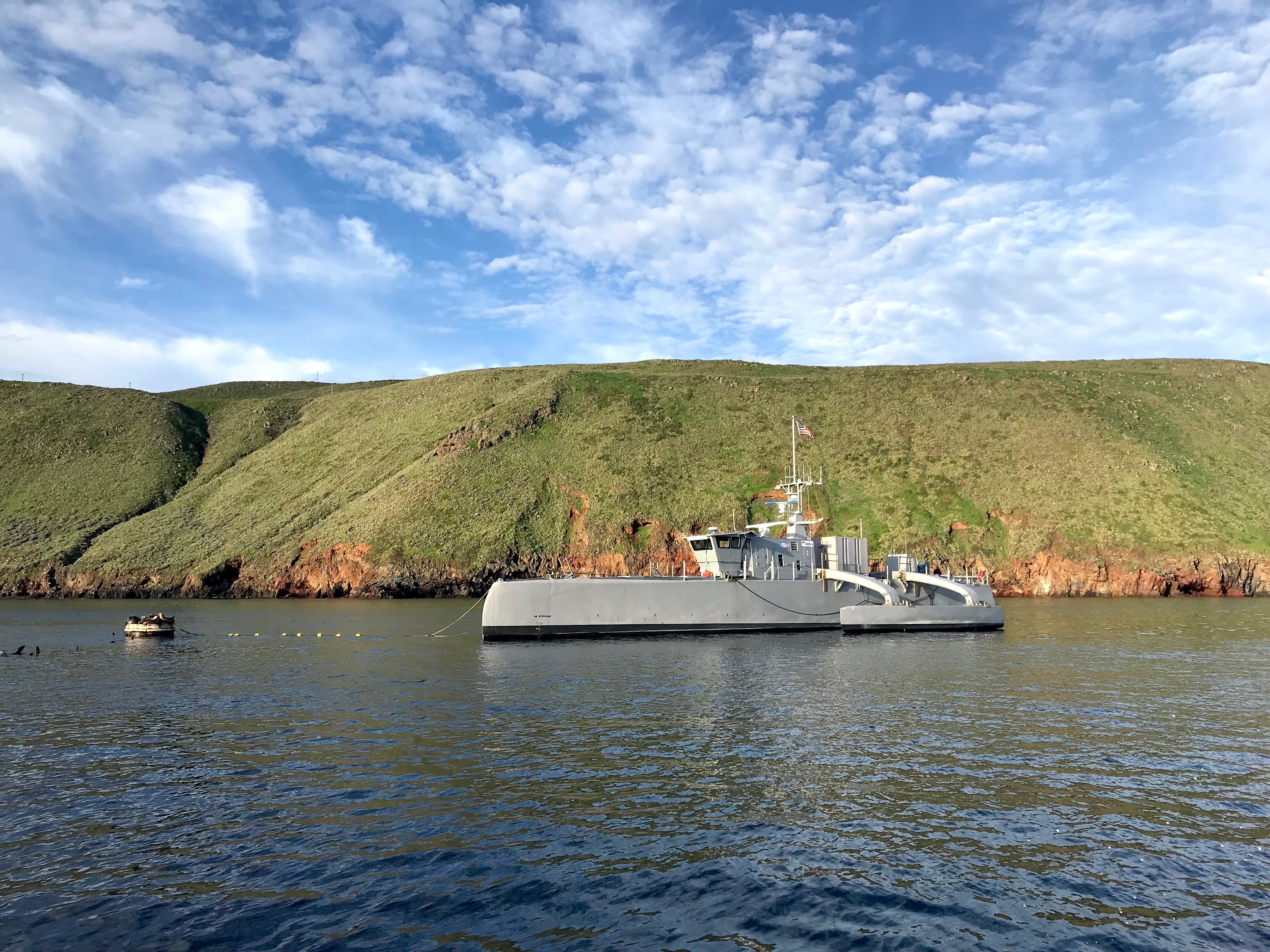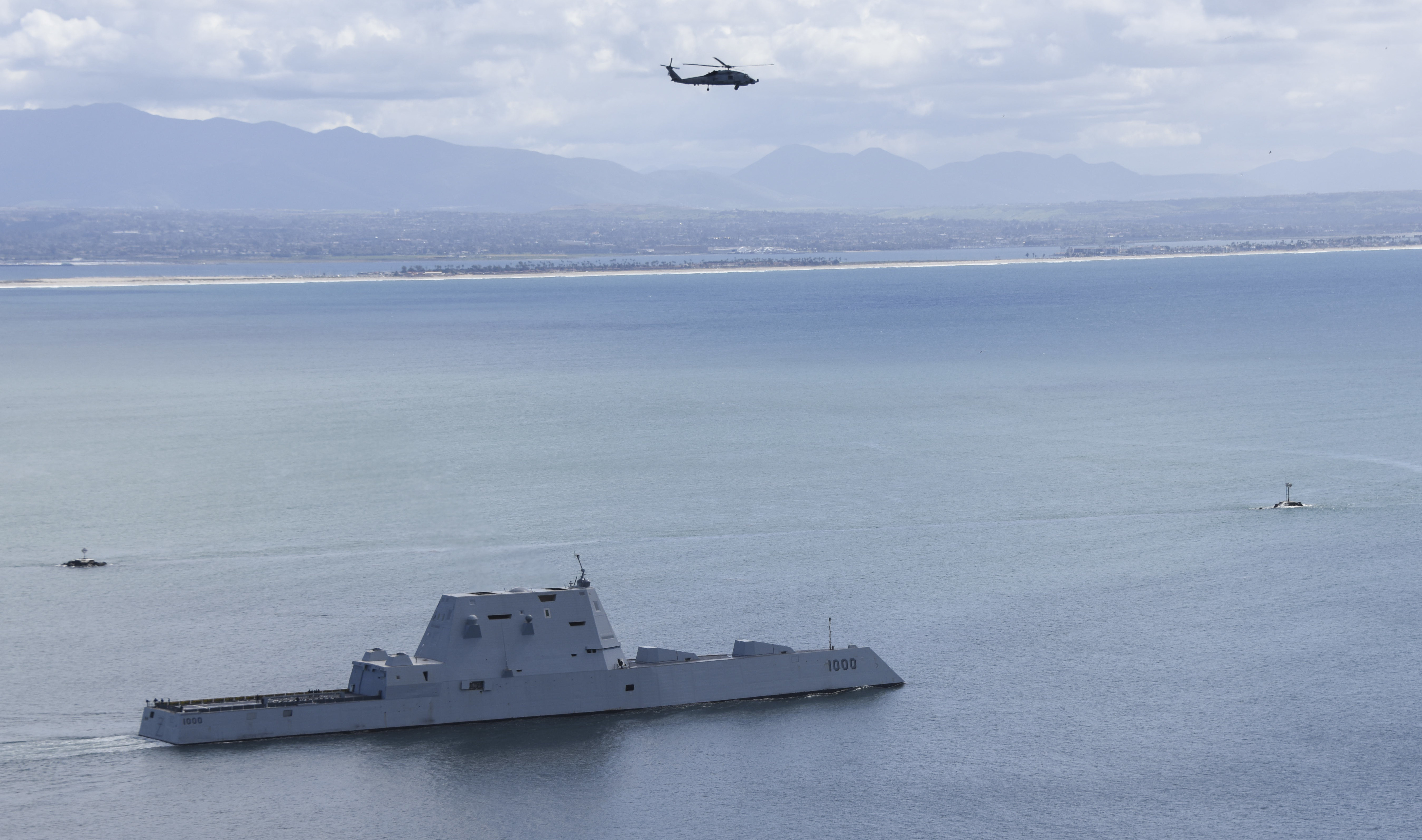
ARLINGTON, Va. – The Navy’s experimentation squadron for unmanned surface vessels has big plans for its second year that include integrating the Sea Hunter Medium USV into a carrier strike group and leading a large U.S. Pacific Fleet experiment this summer.
The Surface Development Squadron 1 was established last May to oversee fleet familiarization, training and tactics development of USVs, as well as the manning, training and equipping of the Zumwalt-class destroyers. In less than a year – and just four months after receiving the first Sea Hunter hull – the organization has done much to develop its staff, draw out a plan for its testing requirements and begin to get fleet sailors familiar and comfortable with the notion of operating alongside a USV, the SURFDEVRON commodore told USNI News.
Capt. Hank Adams, the inaugural commodore of SURFDEVRON-1, told USNI News last week that the Sea Hunter vessel he took command of last fall already had a busy Fiscal Year 2020 schedule, with extensive testing obligations. That said, he’s looking for any opportunities to leverage gaps in the schedule to get the MUSV out to sea alongside any other ships operating off the California coast, be it a Littoral Combat Ship all the way up to a carrier strike group.
“If I can bundle that fleet familiarization with an operator training opportunity with the program-of-record control system, and serve other higher training needs, then I’ll do it. it’s just a matter of finding the opportunity in our schedule,” he told USNI News after speaking at an event co-hosted by AUVSI and the Naval Submarine League.
While the Sea Hunter vessel had already operated with a carrier strike group before coming under the command of SURFDEVRON, Adams said he would do another at-sea test soon where “Sea Hunter will be fully integrated tactically and operationally into a strike group, and that strike group and their warfare commanders are going to employ her tactically, and she will be controlled from the sea.”

He said it would be the first event of that scale under the SURFDEVRON and would hit on several of the squadrons’ missions: “fleet familiarization, fleet training, operator training, advancing the program-of-record control system which is going to be used.” He noted that experts from the Naval Surface and Mine Warfighting Development Center would participate in the event to help collect data and feedback from that event – particularly on the USV control system – which will then be fed into tactics development and the acquisition process.
Adams noted that the control system the CSG staff will use will have safeties in place, but “we’re confident that the control systems will be stable and be effective.”
Sea Hunter 1 and in-construction Sea Hunter 2 are both prototype ships from DARPA and the Office of Naval Research, and two Overlord Large USVs come from a Defense Department Strategic Capabilities Office initiative – but all four vehicles will be transitioned into the SURFDEVRON, and lessons learned will inform new Navy programs of record for a MUSV and LUSV. In fact, by the end of FY 2021 SURFDEVRON will have those four prototype vessels under its command and by FY 2022 or 2023 will have seven total vessels for experimentation and training.
Though this year’s training, including the CSG operations, will help with fleet familiarization and operator training, they are also aimed at nailing down the concepts of operations for the MUSV.
“It’s great to have all this kit, but you’ve got to know what you’re going to do with it,” Adams said at the AUVSI/Sub League event. By September he owes U.S. Fleet Forces Command a draft of the concepts of operations, which he said will include maintenance and logistics concepts as well as operational vignettes to show examples of how the MUSV might be used. Adams made clear that this was just a first draft – the SURFDEVRON is only using a prototype today, not whatever capability ultimately comes off the production line once the Navy lets a contract, and the concepts will evolve once the unmanned vessels hit the waterfront and sailors start having their own ideas for how to leverage a USV.
Another major task for Adams and his staff this year is serving as the officer in tactical command of a PACFLT experiment. Adams said he volunteered for the task as a forcing function to get his squadron fully staffed and help them learn how to plan a large experiment at sea. He did not release many details about the event but said it would be like any other major fleet exercise – but instead of the mission set being anti-submarine warfare or ballistic missile defense, the mission is experimentation.
Adams said he is still learning “how to build an experimentation organization,” but fortunately he has help from his friends in the undersea community. He visited with Submarine Development Squadron 5 at Naval Base Kitsap-Bangor, Wash., as he was standing up his own squadron to understand how the submarine community runs its own developmental squadron.

Adams said during the event that the SUBDEVRON has subordinate squadrons and detachments that cover unmanned undersea vehicles, undersea warfare research and development, and the small three-boat class of Seawolf attack submarines. The SURFDEVRON’s portfolio will similarly cover USVs, surface warfare research and development and the three-ship class of Zumwalt destroyers, and so he’s eyeing a similar organization.
“I foresee sometime down the road when the program-of-record ships begin delivering – and I’m already in conversations with the resource sponsor about this – I see us establishing a USV division that’s going to be subordinate to SURFDEVRON that’s actually going to be that O-5 commander who’s going to be directly in charge and responsible for the program of record unmanned systems,” Adams said.
Additionally, the commodore said, he wants an approach to training and certification more akin to the SUBDEVRON than a traditional squadron. When Adams commanded Destroyer Squadron 21, he was responsible for manning, training and equipping his DDGs, but outside groups such as the Afloat Training Group and Carrier Strike Group 15 actually conducted training events and ultimately certified the ships as ready to deploy. With the SUBDEVRON, though, training and certification authority remains internal to the squadron.
Adams said he hopes to use the SUBDEVRON model, saying he’s now working through “what are the watch functions that require certification, and what is the training program that culminates in an operator who can operate that craft safely and can do that work effectively?”
Overall, Adams said, the task of getting his command stood up and ready to dive into maturing and integrating USVs into the fleet has been made easier due to his collaboration with his counterpart in the sub community.
“I see them as two to three years ahead of us, and it’s a template that at the minimum should be considered, if not really just taken wholly and applied to our context.”





